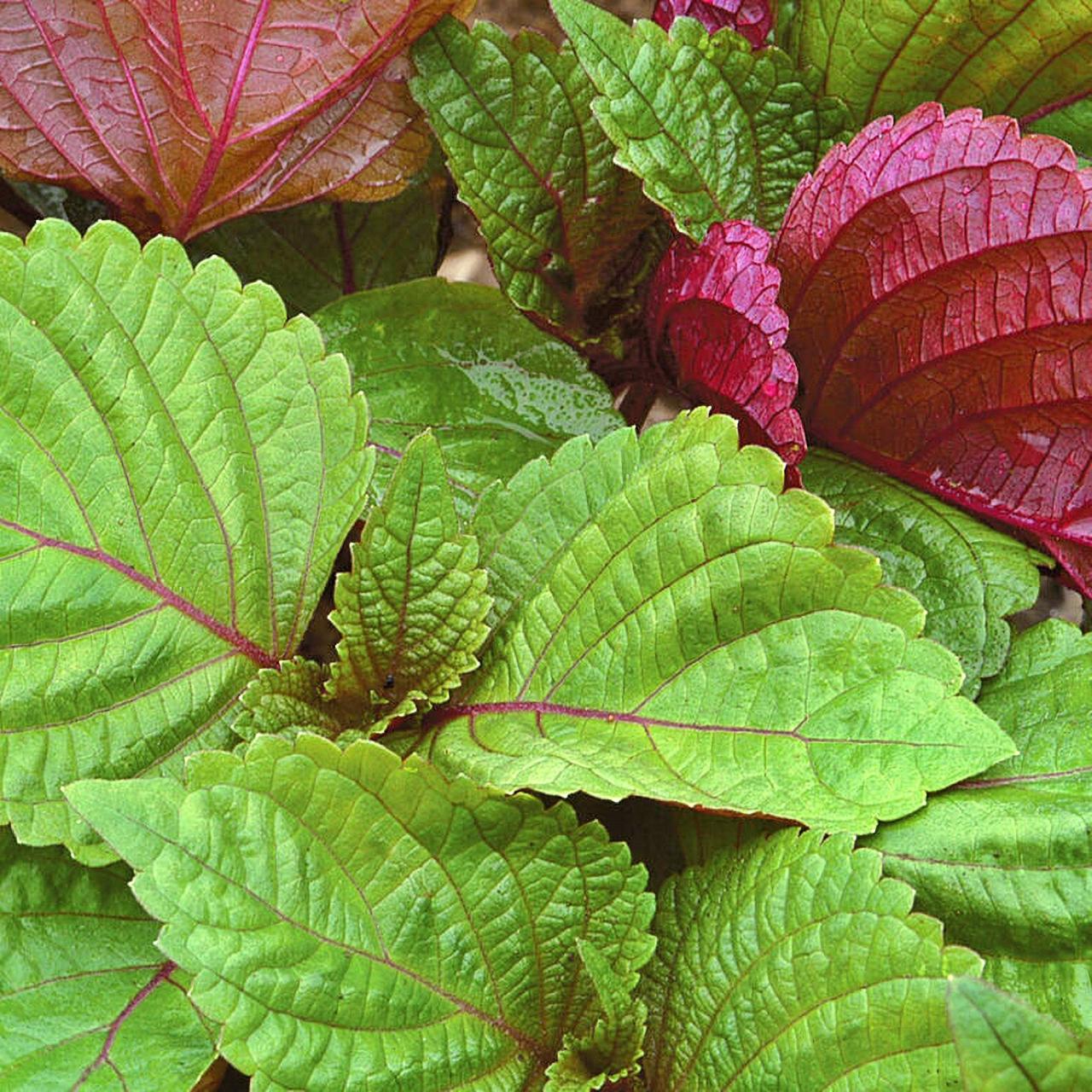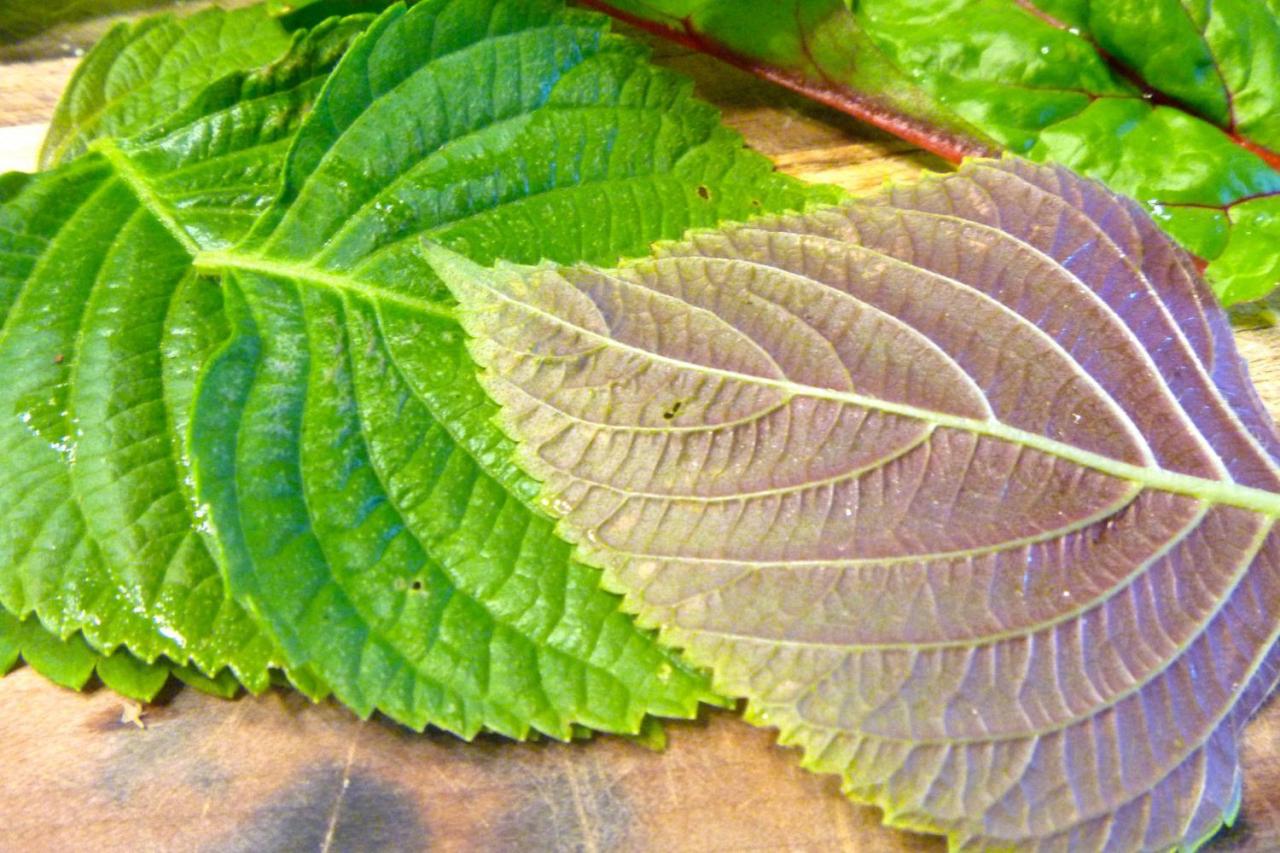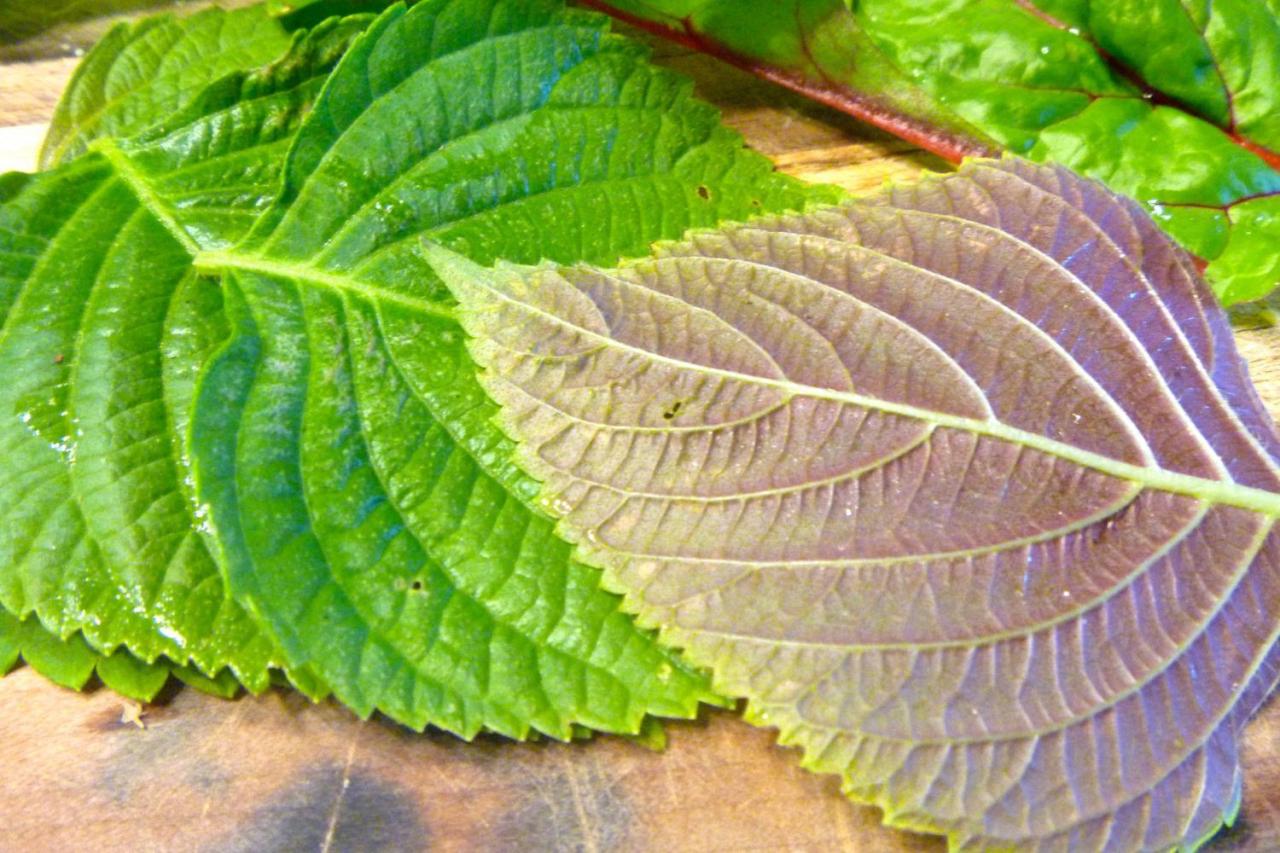Discover the Versatility of Perilla Leaf: Tips for Flavorful and Unique Meals. Perilla leaf, a vibrant green herb with a distinct aroma and flavor, has long been a staple in Asian cuisine. But its unique qualities are now captivating culinary enthusiasts worldwide, offering a fresh and exciting dimension to dishes both familiar and innovative.
From its botanical origins and nutritional value to its diverse culinary applications, this guide delves into the world of perilla leaf, empowering you to explore its versatility and elevate your culinary creations. Prepare to be surprised by the range of flavors and textures this humble leaf can contribute to your meals, from salads and stir-fries to soups and even desserts.
Introduction to Perilla Leaf

Perilla leaf, scientifically known asPerilla frutescens*, is a versatile herb with a long history in Asian cuisine and traditional medicine. This aromatic leaf, often referred to as “shiso” in Japanese, “cha-so” in Korean, and “zi-su” in Chinese, is a member of the mint family and boasts a unique flavor profile and a range of potential health benefits.
Botanical Origin and Characteristics
Perilla leaf is native to East Asia, specifically regions of China, Japan, and Korea. It is an annual plant that grows to a height of 1 to 2 meters, producing vibrant green leaves with a slightly toothed margin. The leaves have a distinct, slightly sweet, and pungent aroma, which is attributed to the presence of volatile compounds like perillaldehyde.
Flavor Profile and Aroma
Perilla leaf possesses a complex and distinctive flavor profile that is both refreshing and intriguing. It has a unique combination of notes, including:
- Minty:Perilla leaf shares a resemblance to mint, with a refreshing and cool sensation on the palate.
- Citrusy:Some varieties exhibit subtle citrusy notes, adding a bright and tangy element to dishes.
- Spicy:A hint of spice, often described as peppery or gingery, adds warmth and complexity to the flavor profile.
- Nutty:Certain varieties of perilla leaf may also have a slightly nutty or sesame-like flavor, contributing to a rich and savory character.
Nutritional Value and Potential Health Benefits, Discover the Versatility of Perilla Leaf: Tips for Flavorful and Unique Meals
Perilla leaf is a nutritional powerhouse, rich in essential vitamins, minerals, and antioxidants. Some of the key nutrients found in perilla leaf include:
- Vitamin A:Perilla leaf is a good source of vitamin A, which is crucial for maintaining healthy vision, skin, and immune function.
- Vitamin C:This powerful antioxidant helps protect cells from damage and supports the immune system.
- Calcium:Essential for strong bones and teeth, calcium is also involved in muscle function and nerve transmission.
- Iron:Iron is a vital component of red blood cells, responsible for transporting oxygen throughout the body.
Perilla leaf has also been associated with various potential health benefits, including:
- Anti-inflammatory properties:The antioxidants in perilla leaf may help reduce inflammation throughout the body.
- Cardiovascular health:Some studies suggest that perilla leaf may help lower blood pressure and improve cholesterol levels.
- Antioxidant activity:Perilla leaf’s antioxidant properties may protect against cell damage caused by free radicals.
- Cognitive function:Preliminary research indicates that perilla leaf may have potential benefits for cognitive function and memory.
Culinary Applications of Perilla Leaf
Perilla leaf, with its distinct aroma and versatility, has found its way into various cuisines worldwide, adding a unique flavor dimension to dishes. From traditional Asian dishes to contemporary culinary creations, this herb offers a range of possibilities for incorporating its unique flavor profile.
Traditional Dishes Featuring Perilla Leaf
Perilla leaf has been a staple in traditional cuisines for centuries, particularly in East Asian countries. Its use in these dishes highlights the herb’s ability to enhance and complement various flavors.
- Korean Cuisine:Perilla leaf, known as “깻잎” (kkaennip), is widely used in Korean cuisine. It is often served as a side dish, “깻잎 장아찌” (kkaennip jangajji), pickled in soy sauce and sesame oil, or as a wrap for grilled meats, “깻잎쌈” (kkaennip ssam).
- Japanese Cuisine:In Japan, perilla leaf, called “しそ” (shiso), is used in various dishes, including “しそ巻き” (shisomaki), where it is wrapped around a filling of rice and pickled plum, and “しそジュース” (shiso juice), a refreshing beverage.
- Chinese Cuisine:Perilla leaf, known as “紫蘇” (zǐsū), is used in Chinese cuisine, often as a garnish or ingredient in stir-fries, soups, and salads.
Perilla Leaf in Salads
Perilla leaf’s fresh, slightly peppery flavor and vibrant color make it an excellent addition to salads. Its versatility allows it to be incorporated into various salad combinations.
- Simple Green Salad:Toss perilla leaves with mixed greens, cucumbers, and cherry tomatoes. Dress with a light vinaigrette of olive oil, lemon juice, and a pinch of salt and pepper.
- Asian-Inspired Salad:Combine perilla leaves with shredded carrots, cabbage, and bean sprouts. Dress with a sesame-ginger dressing.
- Grilled Chicken Salad:Combine grilled chicken breast, perilla leaves, avocado, and toasted almonds. Dress with a honey-lime vinaigrette.
Perilla Leaf in Stir-fries
Perilla leaf’s ability to withstand heat makes it an excellent addition to stir-fries. Its flavor complements a variety of ingredients, adding depth and complexity to the dish.
- Shrimp and Vegetable Stir-fry:Combine shrimp, sliced bell peppers, onions, and perilla leaves. Stir-fry until shrimp is cooked through and vegetables are tender.
- Beef and Broccoli Stir-fry:Combine sliced beef, broccoli florets, and perilla leaves. Stir-fry until beef is cooked through and broccoli is tender-crisp.
- Tofu and Vegetable Stir-fry:Combine tofu, mushrooms, snap peas, and perilla leaves. Stir-fry until tofu is heated through and vegetables are tender.
Perilla Leaf in Marinades
Perilla leaf’s distinct aroma and flavor can be infused into marinades, adding a unique depth to grilled meats, fish, and poultry.
“A marinade with perilla leaf, soy sauce, garlic, and ginger is a popular choice for grilling chicken or pork.”
- Chicken Marinade:Combine perilla leaves, soy sauce, garlic, ginger, and honey. Marinate chicken for at least 30 minutes before grilling.
- Fish Marinade:Combine perilla leaves, lime juice, olive oil, garlic, and chili flakes. Marinate fish for at least 15 minutes before grilling.
- Pork Marinade:Combine perilla leaves, soy sauce, rice wine, garlic, and black pepper. Marinate pork for at least 1 hour before grilling.
Perilla Leaf in Soups, Sauces, and Dips
Perilla leaf’s flavor profile extends beyond salads and stir-fries. It can be incorporated into soups, sauces, and dips, adding a unique twist to these culinary creations.
- Miso Soup:Add a few perilla leaves to traditional miso soup for a subtle, peppery flavor.
- Soy Sauce Dipping Sauce:Combine soy sauce, rice vinegar, sesame oil, and chopped perilla leaves for a flavorful dipping sauce.
- Peanut Sauce:Add chopped perilla leaves to a peanut sauce for a fresh and herbaceous flavor.
Perilla Leaf in Asian Cuisine
Perilla leaf, also known as shiso, is a staple ingredient in many Asian cuisines, adding a unique and vibrant flavor profile to dishes. Its versatility and distinct aroma have made it a beloved herb throughout the region, with different cultures incorporating it into their culinary traditions in diverse ways.
The Use of Perilla Leaf in Different Asian Cuisines
The use of perilla leaf varies across different Asian cuisines, reflecting the diverse culinary traditions and preferences of each region. While it is commonly used in Japanese, Korean, and Chinese cooking, the specific applications and flavors it imparts differ significantly.
Perilla Leaf in Japanese Cuisine
In Japanese cuisine, perilla leaf, known as shiso, is a ubiquitous ingredient, prized for its distinct aroma and flavor. It is commonly used both fresh and dried, adding a refreshing, slightly minty, and subtly spicy note to dishes.
“Shiso is a versatile herb that can be used in a variety of ways. It can be added to salads, soups, and stir-fries, or used as a garnish. It is also used to make pickles, chutneys, and other condiments.”
Perilla Leaf in Korean Cuisine
In Korean cuisine, perilla leaf, known as kkaennip, is a popular ingredient, often used to add a unique flavor and aroma to dishes. It is commonly used in both fresh and dried forms, with its distinct, slightly spicy and citrusy flavor complementing a wide range of dishes.
“Kkaennip is often used in Korean dishes like bibimbap, a mixed rice dish, and kimchi, a fermented cabbage dish. It is also used to make a type of tea called kkaennipcha.”
Perilla Leaf in Chinese Cuisine
In Chinese cuisine, perilla leaf, known as suziye, is used less frequently than in Japanese and Korean cuisines. However, it is still a valuable ingredient, particularly in southern Chinese cooking, where its distinct aroma and flavor are appreciated.
“Suziye is often used in stir-fries, soups, and stews. It is also used to make a type of tea called suziye cha.”
Dishes with Perilla Leaf
Dish |
Ingredients |
Perilla Leaf Usage |
Cuisine |
|---|---|---|---|
Bibimbap |
Rice, vegetables, meat, egg, gochujang (Korean chili paste) |
Fresh perilla leaves are often used as a garnish or mixed into the rice bowl. |
Korean |
Kimchi |
Cabbage, garlic, ginger, chili powder, salt, fish sauce |
Perilla leaves are sometimes added to kimchi for their distinct flavor and aroma. |
Korean |
Sashimi |
Raw fish, soy sauce, wasabi |
Perilla leaves are often used as a garnish for sashimi, adding a refreshing and aromatic touch. |
Japanese |
Gyoza |
Pork, vegetables, garlic, ginger, soy sauce |
Perilla leaves can be added to the gyoza filling for a unique flavor and aroma. |
Japanese |
Perilla Leaf in Western Cuisine

Perilla leaf, with its unique flavor profile, can seamlessly integrate into Western cuisine, adding a refreshing twist to familiar dishes. Its versatility allows it to be incorporated into various culinary creations, from pasta and pizzas to sandwiches and salads.
Pairing Perilla Leaf with Western Ingredients
Perilla leaf’s distinct flavor lends itself well to various pairings with Western ingredients. Its subtle, minty aroma complements a wide range of proteins, vegetables, and cheeses.
- Proteins:Perilla leaf pairs beautifully with grilled chicken, salmon, and pork. Its refreshing flavor cuts through the richness of the protein, adding a vibrant note.
- Vegetables:Its minty flavor complements tomatoes, cucumbers, and bell peppers, creating a refreshing and aromatic combination.
- Cheeses:Perilla leaf complements creamy cheeses like ricotta, goat cheese, and mozzarella. The combination of its subtle minty notes and the creamy richness of cheese creates a harmonious and flavorful experience.
Tips for Using Perilla Leaf
Perilla leaf, a versatile herb with a unique flavor profile, can elevate your culinary creations. To maximize its flavor and ensure optimal freshness, it’s crucial to select, store, and prepare perilla leaves correctly.
Selecting Fresh Perilla Leaves
Choosing fresh perilla leaves is essential for unlocking their full flavor potential. Here’s what to look for:
- Vibrant Color:Opt for leaves that are a deep green or purple, depending on the variety. Avoid leaves that are dull or yellowing, as this indicates they are past their prime.
- Firm Texture:Fresh perilla leaves should feel firm and crisp to the touch. Avoid leaves that are wilted or limp.
- Absence of Damage:Inspect the leaves for any signs of damage, such as holes, tears, or brown spots. These imperfections can affect the flavor and appearance of the leaves.
- Pleasant Aroma:Fresh perilla leaves should have a distinct, slightly minty aroma. If the leaves have a stale or unpleasant smell, they may be past their peak freshness.
Storing and Preserving Perilla Leaves
Proper storage is crucial for maintaining the freshness and flavor of perilla leaves.
- Refrigeration:Store fresh perilla leaves in a sealed plastic bag or container in the refrigerator. This will help to prevent them from wilting and losing moisture.
- Freezing:To preserve perilla leaves for longer periods, you can freeze them. Wash and dry the leaves thoroughly, then place them in a freezer-safe bag or container. Freeze them flat for easier storage and retrieval. Frozen perilla leaves can be used in stir-fries, soups, or sauces.
Preparing Perilla Leaves
Perilla leaves can be prepared in various ways to enhance their flavor and texture.
- Chopping:Finely chop perilla leaves for use in stir-fries, sauces, or garnishes. This method allows the leaves to infuse their flavor into the dish while maintaining a delicate texture.
- Shredding:Shred perilla leaves for salads or wraps. This method provides a more substantial texture and allows the leaves to add a refreshing element to the dish.
- Grilling:Grill perilla leaves for a smoky flavor. This method can be used to enhance the flavor of the leaves and add a unique element to dishes. Grilling can be done over a gas or charcoal grill, or even in a pan over medium heat.
Discover the versatility of perilla leaf, a unique ingredient that adds a touch of vibrant color and distinct flavor to your meals. From its aromatic leaves to its colorful seeds, perilla offers a range of culinary possibilities. For a beautiful autumnal display, consider crafting a garland using vibrant leaves, inspired by the detailed instructions found in this helpful guide: Step-by-Step: How to Craft a Beautiful Autumn Leaf Garland for Your Home.
Once you’ve created your decorative garland, you can incorporate the earthy flavors of perilla into your autumnal dishes, adding a unique twist to your seasonal cuisine.
Creative Uses of Perilla Leaf
Perilla leaf’s versatility extends beyond traditional culinary applications. Its unique flavor profile and aromatic qualities make it an excellent ingredient for creating innovative and flavorful dishes, drinks, and even garnishes.
Infused Oils, Vinegars, and Teas
Perilla leaf can infuse oils, vinegars, and teas, adding a distinct flavor and aroma to various dishes and beverages.
- Infused Oils:Perilla leaf can be infused in olive oil or other neutral oils to create a flavorful oil that can be used for drizzling over salads, pasta, or vegetables. The oil can also be used for cooking or as a marinade for meat and poultry.
To infuse oil, simply combine fresh perilla leaves with oil in a clean jar, seal tightly, and store in a cool, dark place for at least 2 weeks, shaking occasionally. Strain the oil before using.
- Infused Vinegars:Perilla leaf can also be infused in vinegar, such as apple cider vinegar or white wine vinegar, to create a tangy and aromatic vinegar that can be used for salad dressings, marinades, or sauces. Infusion can be done similarly to oil infusion, using fresh perilla leaves and vinegar in a jar.
- Infused Teas:Perilla leaf can be used to create a refreshing and flavorful tea. To make perilla leaf tea, simply steep a few fresh or dried leaves in hot water for 5-10 minutes. You can also combine perilla leaf with other herbs and spices, such as ginger, mint, or lemon balm, for a more complex flavor.
Perilla Leaf Pesto and Flavorful Sauces
Perilla leaf can be used to create unique and flavorful pestos and sauces that can enhance the taste of various dishes.
Perilla leaf, with its unique flavor profile and vibrant color, can elevate any dish. Its versatility extends beyond culinary applications, inspiring creativity in home décor. For a touch of autumnal charm, consider crafting a leaf garland using the vibrant hues of perilla leaves, as seen in this inspiring DIY project, Autumn Leaf Garland DIY: Transform Your Space with These Creative Ideas.
This project not only showcases the beauty of perilla but also adds a touch of nature to your home, complementing the vibrant flavors of your perilla-infused meals.
- Perilla Leaf Pesto:A simple perilla leaf pesto can be made by blending fresh perilla leaves, garlic, olive oil, pine nuts, and Parmesan cheese. This pesto can be used as a spread on sandwiches or crackers, or as a sauce for pasta, grilled fish, or chicken.
- Perilla Leaf Sauce:Perilla leaf can also be used to create a flavorful sauce that can be used for stir-fries, noodles, or dumplings. A simple sauce can be made by combining chopped perilla leaves, soy sauce, rice vinegar, sesame oil, and sugar.
Desserts, Drinks, and Garnishes
Perilla leaf’s unique flavor profile and aromatic qualities can add a distinct touch to desserts, drinks, and garnishes.
- Desserts:Perilla leaf can be incorporated into desserts, such as ice cream, sorbet, or cakes, for a subtle yet flavorful twist. For instance, a perilla leaf sorbet can be made by blending perilla leaves with sugar, water, and lemon juice.
- Drinks:Perilla leaf can be used to create refreshing and flavorful drinks, such as cocktails, smoothies, or iced teas. A perilla leaf mojito, for example, can be made by muddling perilla leaves with mint leaves, sugar, and lime juice, and then adding rum and club soda.
- Garnishes:Perilla leaf can be used as a garnish for various dishes, such as salads, soups, or sushi, to add a touch of color, flavor, and aroma.
Conclusive Thoughts: Discover The Versatility Of Perilla Leaf: Tips For Flavorful And Unique Meals
As you explore the world of perilla leaf, embrace its unique flavor profile and versatility. From traditional Asian dishes to innovative Western creations, this herb offers a wealth of culinary possibilities. Experiment with different preparations, pairings, and techniques to discover the true potential of perilla leaf and elevate your culinary creations to new heights.
Answers to Common Questions
Where can I find perilla leaf?
Perilla leaf is becoming increasingly available at Asian grocery stores, specialty markets, and some mainstream supermarkets. You can also find it online from various vendors.
Is perilla leaf the same as shiso?
Yes, perilla leaf and shiso are the same plant. The name “shiso” is more commonly used in Japanese cuisine.
Can I substitute perilla leaf for other herbs?
While perilla leaf has a unique flavor, you can sometimes substitute it with other herbs like basil, mint, or cilantro, depending on the dish. However, the flavor will be different.
